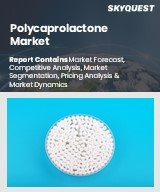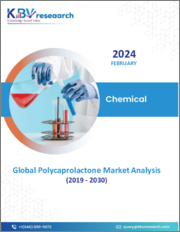
|
시장보고서
상품코드
1820128
폴리카프로락톤 시장 보고서 : 형태별, 제조 방법별, 용도별, 지역별(2025-2033년)Polycaprolactone Market Report by Form, Production Method, Application, and Region 2025-2033 |
||||||
세계 폴리카프로락톤 시장 규모는 2024년 6억 6,800만 달러에 달했습니다. 향후 IMARC Group은 2033년까지 시장 규모가 14억 2,000만 달러에 달해 2025년부터 2033년까지 8.7%의 연평균 성장률(CAGR)을 기록할 것으로 예상하고 있습니다.
폴리카프로락톤(PCL)은 화석에서 유래한 생분해성 반결정 폴리에스테르로 열처리 및 3차원 바이오프린팅에 사용됩니다. 일반적으로 펠릿, 나노스피어, 마이크로스피어 형태로 제공되며, 자연계에서는 무독성이며, 열, 습기, 미생물에 노출되면 유기 성분으로 분해됩니다. 개환중합 및 카르복시산의 중축합법을 사용하여 제조되며, 유기용매에 대한 용해도가 높고 융점이 낮습니다. PCL은 일반적으로 수지의 첨가제로 사용되며, 보석 및 제품 모형과 시제품, 의료기기, 자동차 부품, 건축자재 제조에 사용됩니다. 또한 코팅제, 접착제, 실링제, 엘라스토머 제조에도 널리 이용되고 있습니다.
폴리카프로락톤 시장 동향:
세계 의료 산업의 괄목할만한 성장은 시장의 밝은 전망을 만들어내는 중요한 요인 중 하나입니다. PCL은 의료용 정형외과, 치과, 외과용 임플란트, 약물전달 기기, 상처 드레싱 테이프, 조직 공학, 재생의료 시스템 제조에 널리 사용되고 있습니다. 또한, 열가소성 폴리우레탄의 배합에 PCL이 널리 채택되고 있는 것도 시장 성장을 촉진하고 있습니다. PCL은 우수한 소수성, 내유성, 내화학성, 자외선(UV) 저항성을 나타냅니다. 또한 폴리염화비닐(PVC)의 탄성을 높이는 고분자 가소제로도 사용됩니다. 또한, 다양한 제품 혁신과 벽, 지붕, 문, 창문의 방음재로 건설 업계에서 PCL이 활용되고 있는 것도 성장을 촉진하는 요인으로 작용하고 있습니다. 이에 따라 감압 마이크로 전자부품의 봉지 및 밀봉용으로 환경 친화적이고 비용 효율적인 소재에 대한 수요가 증가하고 있어 시장 성장이 예상됩니다.
본 보고서에서 다루는 주요 질문
- 폴리카프로락톤 세계 시장 규모는?
- 2025-2033년 폴리카프로락톤 세계 시장 성장률 전망은?
- 폴리카프로락톤 세계 시장을 이끄는 주요 요인은 무엇인가?
- COVID-19가 폴리카프로락톤 세계 시장에 미치는 영향은?
- 세계 시장에서 폴리카프로락톤의 형태별 분류는?
- 세계 시장에서 폴리카프로락톤의 생산 방법별 분류는?
- 폴리카프로락톤 세계 시장 용도별 분류는?
- 폴리카프로락톤 세계 시장 주요 지역은?
- 세계 폴리카프로락톤 시장의 주요 기업은?
목차
제1장 서문
제2장 조사 범위와 조사 방법
- 조사 목적
- 이해관계자
- 데이터 소스
- 1차 정보
- 2차 정보
- 시장 추정
- 상향식 접근
- 하향식 접근
- 조사 방법
제3장 주요 요약
제4장 소개
제5장 세계의 폴리카프로락톤 시장
- 시장 개요
- 시장 실적
- COVID-19의 영향
- 시장 예측
제6장 시장 내역 : 형태별
- 펠릿
- 나노스피어
- 마이크로스피어
제7장 시장 내역 : 제조 방법별
- 개환 중합
- 카복실산 중축합
제8장 시장 내역 : 용도별
- 코팅 및 열가소성 폴리우레탄
- 헬스케어
- 기타
제9장 시장 내역 : 지역별
- 북미
- 미국
- 캐나다
- 아시아태평양
- 중국
- 일본
- 인도
- 한국
- 호주
- 인도네시아
- 기타
- 유럽
- 독일
- 프랑스
- 영국
- 이탈리아
- 스페인
- 러시아
- 기타
- 라틴아메리카
- 브라질
- 멕시코
- 기타
- 중동 및 아프리카
제10장 SWOT 분석
제11장 밸류체인 분석
제12장 Porter's Five Forces 분석
제13장 가격 분석
제14장 경쟁 구도
- 시장 구조
- 주요 기업
- 주요 기업 개요
- BASF SE
- Corbion N.V.
- Daicel Corporation
- Haihang Industry
- Merck KGaA
- Perstorp Holding AB
- Polysciences Inc
- Shenzhen Esun Industrial Co.Ltd
- Shenzhen Polymtek Biomaterial Co. Ltd
The global polycaprolactone market size reached USD 668.0 Million in 2024. Looking forward, IMARC Group expects the market to reach USD 1,420.0 Million by 2033, exhibiting a growth rate (CAGR) of 8.7% during 2025-2033.
Polycaprolactone (PCL) is a fossil-based, biodegradable and semicrystalline polyester used for thermal processing and 3-Dimensional bioprinting. It is commonly available in the form of pellets, nanospheres and microspheres, which are non-toxic in nature and breaks down into organic components upon exposed to heat, moisture and microorganisms. It is produced using ring-opening polymerization and polycondensation of carboxylic acid methods and exhibit high solubility in organic solvents and low melting point. PCL is commonly used as an additive in resins and for manufacturing jewelry and models and prototypes of products, medical devices, automotive components and construction materials. It is also widely utilized for the production of coatings, adhesives, sealants and elastomers.
Polycaprolactone Market Trends:
Significant growth in the medical industry across the globe is one of the key factors creating a positive outlook for the market. PCL is widely used for the manufacturing of medical-grade orthopedic, dental and surgical implants, drug delivery devices, wound dressing tapes, tissue engineering and regenerative medicine systems. Moreover, the widespread adoption of PCL in the formulation of thermoplastic polyurethane is providing a thrust to the market growth. It exhibits superior hydrophobic properties, resistance to oil, chemical and ultraviolet (UV) rays. It is also used as a polymeric plasticizer to polyvinyl chloride (PVC) to increase its elasticity. Additionally, various product innovations and the utilization of PCL in the construction industry as a noise insulation material for walls, roofs, doors and windows are acting as other growth-inducing factors. In line with this, the rising demand for environment-friendly and cost-effective materials for sealing and encapsulating pressure-sensitive microelectronic components is anticipated to drive the market toward growth.
Key Market Segmentation:
Breakup by Form:
- Pellets
- Nanosphere
- Microsphere
Breakup by Production Method:
- Ring Opening Polymerization
- Polycondesation of Carboxylic Acid
Breakup by Application:
- Coating and Thermoplastic Polyurethane
- Healthcare
- Others
Breakup by Region:
- North America
- United States
- Canada
- Asia-Pacific
- China
- Japan
- India
- South Korea
- Australia
- Indonesia
- Others
- Europe
- Germany
- France
- United Kingdom
- Italy
- Spain
- Russia
- Others
- Latin America
- Brazil
- Mexico
- Others
- Middle East and Africa
Competitive Landscape:
The competitive landscape of the industry has also been examined along with the profiles of the key players being BASF SE, Corbion N.V., Daicel Corporation, Haihang Industry, Merck KGaA, Perstorp Holding AB, Polysciences Inc, Shenzhen Esun Industrial Co.Ltd and Shenzhen Polymtek Biomaterial Co. Ltd.
Key Questions Answered in This Report
- 1.How big is the global polycaprolactone market?
- 2.What is the expected growth rate of the global polycaprolactone market during 2025-2033?
- 3.What are the key factors driving the global polycaprolactone market?
- 4.What has been the impact of COVID-19 on the global polycaprolactone market?
- 5.What is the breakup of the global polycaprolactone market based on the form?
- 6.What is the breakup of the global polycaprolactone market based on the production method?
- 7.What is the breakup of the global polycaprolactone market based on the application?
- 8.What are the key regions in the global polycaprolactone market?
- 9.Who are the key players/companies in the global polycaprolactone market?
Table of Contents
1 Preface
2 Scope and Methodology
- 2.1 Objectives of the Study
- 2.2 Stakeholders
- 2.3 Data Sources
- 2.3.1 Primary Sources
- 2.3.2 Secondary Sources
- 2.4 Market Estimation
- 2.4.1 Bottom-Up Approach
- 2.4.2 Top-Down Approach
- 2.5 Forecasting Methodology
3 Executive Summary
4 Introduction
- 4.1 Overview
- 4.2 Key Industry Trends
5 Global Polycaprolactone Market
- 5.1 Market Overview
- 5.2 Market Performance
- 5.3 Impact of COVID-19
- 5.4 Market Forecast
6 Market Breakup by Form
- 6.1 Pellets
- 6.1.1 Market Trends
- 6.1.2 Market Forecast
- 6.2 Nanosphere
- 6.2.1 Market Trends
- 6.2.2 Market Forecast
- 6.3 Microsphere
- 6.3.1 Market Trends
- 6.3.2 Market Forecast
7 Market Breakup by Production Method
- 7.1 Ring Opening Polymerization
- 7.1.1 Market Trends
- 7.1.2 Market Forecast
- 7.2 Polycondesation of Carboxylic Acid
- 7.2.1 Market Trends
- 7.2.2 Market Forecast
8 Market Breakup by Application
- 8.1 Coating and Thermoplastic Polyurethane
- 8.1.1 Market Trends
- 8.1.2 Market Forecast
- 8.2 Healthcare
- 8.2.1 Market Trends
- 8.2.2 Market Forecast
- 8.3 Others
- 8.3.1 Market Trends
- 8.3.2 Market Forecast
9 Market Breakup by Region
- 9.1 North America
- 9.1.1 United States
- 9.1.1.1 Market Trends
- 9.1.1.2 Market Forecast
- 9.1.2 Canada
- 9.1.2.1 Market Trends
- 9.1.2.2 Market Forecast
- 9.1.1 United States
- 9.2 Asia-Pacific
- 9.2.1 China
- 9.2.1.1 Market Trends
- 9.2.1.2 Market Forecast
- 9.2.2 Japan
- 9.2.2.1 Market Trends
- 9.2.2.2 Market Forecast
- 9.2.3 India
- 9.2.3.1 Market Trends
- 9.2.3.2 Market Forecast
- 9.2.4 South Korea
- 9.2.4.1 Market Trends
- 9.2.4.2 Market Forecast
- 9.2.5 Australia
- 9.2.5.1 Market Trends
- 9.2.5.2 Market Forecast
- 9.2.6 Indonesia
- 9.2.6.1 Market Trends
- 9.2.6.2 Market Forecast
- 9.2.7 Others
- 9.2.7.1 Market Trends
- 9.2.7.2 Market Forecast
- 9.2.1 China
- 9.3 Europe
- 9.3.1 Germany
- 9.3.1.1 Market Trends
- 9.3.1.2 Market Forecast
- 9.3.2 France
- 9.3.2.1 Market Trends
- 9.3.2.2 Market Forecast
- 9.3.3 United Kingdom
- 9.3.3.1 Market Trends
- 9.3.3.2 Market Forecast
- 9.3.4 Italy
- 9.3.4.1 Market Trends
- 9.3.4.2 Market Forecast
- 9.3.5 Spain
- 9.3.5.1 Market Trends
- 9.3.5.2 Market Forecast
- 9.3.6 Russia
- 9.3.6.1 Market Trends
- 9.3.6.2 Market Forecast
- 9.3.7 Others
- 9.3.7.1 Market Trends
- 9.3.7.2 Market Forecast
- 9.3.1 Germany
- 9.4 Latin America
- 9.4.1 Brazil
- 9.4.1.1 Market Trends
- 9.4.1.2 Market Forecast
- 9.4.2 Mexico
- 9.4.2.1 Market Trends
- 9.4.2.2 Market Forecast
- 9.4.3 Others
- 9.4.3.1 Market Trends
- 9.4.3.2 Market Forecast
- 9.4.1 Brazil
- 9.5 Middle East and Africa
- 9.5.1 Market Trends
- 9.5.2 Market Breakup by Country
- 9.5.3 Market Forecast
10 SWOT Analysis
- 10.1 Overview
- 10.2 Strengths
- 10.3 Weaknesses
- 10.4 Opportunities
- 10.5 Threats
11 Value Chain Analysis
12 Porters Five Forces Analysis
- 12.1 Overview
- 12.2 Bargaining Power of Buyers
- 12.3 Bargaining Power of Suppliers
- 12.4 Degree of Competition
- 12.5 Threat of New Entrants
- 12.6 Threat of Substitutes
13 Price Analysis
14 Competitive Landscape
- 14.1 Market Structure
- 14.2 Key Players
- 14.3 Profiles of Key Players
- 14.3.1 BASF SE
- 14.3.1.1 Company Overview
- 14.3.1.2 Product Portfolio
- 14.3.1.3 Financials
- 14.3.1.4 SWOT Analysis
- 14.3.2 Corbion N.V.
- 14.3.2.1 Company Overview
- 14.3.2.2 Product Portfolio
- 14.3.2.3 Financials
- 14.3.3 Daicel Corporation
- 14.3.3.1 Company Overview
- 14.3.3.2 Product Portfolio
- 14.3.3.3 Financials
- 14.3.3.4 SWOT Analysis
- 14.3.4 Haihang Industry
- 14.3.4.1 Company Overview
- 14.3.4.2 Product Portfolio
- 14.3.5 Merck KGaA
- 14.3.5.1 Company Overview
- 14.3.5.2 Product Portfolio
- 14.3.5.3 Financials
- 14.3.5.4 SWOT Analysis
- 14.3.6 Perstorp Holding AB
- 14.3.6.1 Company Overview
- 14.3.6.2 Product Portfolio
- 14.3.6.3 SWOT Analysis
- 14.3.7 Polysciences Inc
- 14.3.7.1 Company Overview
- 14.3.7.2 Product Portfolio
- 14.3.8 Shenzhen Esun Industrial Co.Ltd
- 14.3.8.1 Company Overview
- 14.3.8.2 Product Portfolio
- 14.3.9 Shenzhen Polymtek Biomaterial Co. Ltd
- 14.3.9.1 Company Overview
- 14.3.9.2 Product Portfolio
- 14.3.1 BASF SE



















